**7th-Great paternal Grandparents of Eula Claudine Reed
Gerrit Hendricks de Wees**:
Parents: Hendrick DeWees & Adriaentje Jans
Born: About 1641-1642 (Amsterdam, Dutch Republic)
Died: About 1701 (Philadelphia County, Pennsylvania)
Buried: Upper Burial Grounds (Germantown, Pennsylvania)
Sijtske “Zytian” Lieuwes** (spouse):
Parents: Liuwes Lamberts & Dievertie ?
Born: About 1649 ? (Leeuwarden, Dutch Republic)
Married: September 28, 1662 (Leeuwarden, Dutch Republic)
Died: About 1703 (Philadelphia County, Pennsylvania)
Buried: Upper Burial Grounds (Germantown, Pennsylvania)
Children:
- Willemyntie Pietre de Wees (Born: 3/13/1663);
- Willem de Wees (Baptism: 11/9/1664);
- Dievertie de Wees (Baptism: 7/11/1666);
- Lambertus de Wees (Baptism: 5/5/1672);
- Ariaentie de Wees (Baptism: 9/24/1673);
- Liuwes “Lewis” Lambert de Wees (Baptism: 10/3/1675);
- Hendrick de Wees (Baptism: 10/13/1677);
- Wilhelm “William” DeWees (Baptism: 3/30/1680);
- Lysbeth ? de Wees (Baptism: 4/2/1681);
- Cornelius DeWees** (Baptism: 12/20/1682).
Genealogical Sketch:
Extensive research by the “Dewees National Research Team” has shown that “virtually all Americans bearing the surname Dewees or Deweese are descended from Gerrit Hendricks de Wees” which has been supported by Y-DNA testing (see Updates from the Dewees[e] Surname Project).[1] At the time Gerrit Hendricks de Wees lived, it was not customary for the Dutch (including people from the Province of Friesland) to use the paternal surname (i.e., de Wees) as was conventionally done in Britain. Instead, a possessive prefix or suffix would be added to the given name (known as patronymics) to convey that an individual was from (the child of) the father. Accordingly, Hendrick de Wees’ son Gerrit would would have been recorded as Gerrit Hendricks, Gerrit Hendrixs, Gerrit Hendrickszen, Gerrit Hendrickse, or a similar deviation.[2] To help alleviate confusion, the place the person was born would follow the possessive form of their father’s given name. As a result, Gerrit Hendricks of Amsterdam indicated Gerrit was the son of Hendrick and was born in Amsterdam.
- During the Renaissance period, the the Dutch had won independence from Spain and become a global nautical power by developing an extensive merchant fleet and navy. As Dutch society became increasingly integrated and mobile, it became increasingly important to be able to check the credibility and reputation of an individuals by knowing the name of their father and the place they were from.
The son of Hendrick Adriaens de Wees and Ariaentje Jans, Gerrit Hendricks de Wees was born in Amsterdam (Dutch Republic) in 1640. Following the death of his father in 1661, the twenty-one year old Gerrit (de Wees) was named as one of the surviving children in the Orphan Court records of the City of Amsterdam dated November 24, 1661. Although the date of her birth is not proven, Sijtske Lieuwes’ father is believed to have been Lieuwes Lamberts and her mother was believed to have been Dievertie (based on Dutch naming conventions).[3]
According to the Leeuwarden Reformed Dutch Church marriage records, “Gerrijt Hendrix, from Amsterdam, and Sijtske Liuwes, in this town,” were married in Leeuwarden of the province of Friesland on September 14, 1662.[4] Located about 90 miles north of Amsterdam, Leeuwarden was the capital of the province of Friesland in the Dutch Republic (aka: the United Provinces of the Netherlands). An uncommon name in the province of Friesland, Sijtske (also spelled Sytske or Sitske) is a Frisian variant form of the name Sytie which is a shorten form of names beginning with the Germanic element “Sigu” (given names in Frisian would have been “Sigurd” or “Sjoerd”). Liuwes (also spelled Lieuwes or Lievens) indicates the name of Sijtske’s father was Liuwe or Lieuwe (also spelled Lieven) which was commonly translated to “Lewis” in english.[5]
Transcription of marriage record: “Gerrijt Hendrix, van Amsterdam, ende Sijtske Liuwes, in desen stedt, zijn voor die eerste maeU den 14 7 ber 1662 afgelesen, ten rweden den 21 dito, ten derden den 28 dito en zijn den selven dito bevestiget.”
English Translation: “Gerrijt Hendrix, from Amsterdam, and Sijtske Liuwes, in this town, banns proclaimed for the first time 14 September 1662, for the second time 21 ditto, for the third time 28 ditto, and on the same date [they] were married.”
- The language most common in the province of Friesland was “Frisian” which is similar to the western germanic dialects of “Low German” and “Low Saxon”. In Pennsylvania, emigrants that spoke dialects of “Low German” lived in communities together due to the language barrier with the other english speaking emigrants and their language became known as “Pennsylvania Dutch”. There are some older Mennonites and Amish communities in Pennsylvania and other regions of America that still speak “Pennsylvania Dutch” to this day. This is likely why the DeWees family Bible (only included the book of Psalms) of the 4th-Granddaughter of Gerrit Hendricks de Wees and his wife Sijtske, Sarah Jane DeWeese (Kennedy)**, was written in German (possibly “Low German”).
On March 13, 1663, it is believed the daughter of Gerrit Hendricks de Wees and his wife Sytie (Willemyntie Pietre de Wees) was born in Leeuwarden in province of Friesland in the Dutch Republic. According to a letter (likely dated in the late 1800’s) sent “from a gentleman in Lieuwarden” that included “Born on 13th March 1673. Wilhelmina Pietre de Wees. From Parish Register Lieuwarden Province, Friesland, Holland.“[6] Since other records support that Willemyntie de Wees was born in Leeuwarden, it is believed Gerrit Hendricks de Wees and his wife Sytie remained in Leeuwarden (Friesland) following their marriage until the family departed for New Amsterdam sometime in 1663 or 1664.
- In 1626, the West India Company (chartered by the Dutch Parliament) established Fort Amsterdam on the southern tip of Manhattan Island to protect their lucrative fur trade. The director of the West India Company, Peter Minuit, had reportedly traded 60 Dutch guilders of goods to the native Indians for Manhattan Island. The Dutch fur trade operated by the West India Company followed along the Hudson River up to Fort Orange (present-day Albany, New York). After capturing the New Sweden’s Fort Christina (Wilmington, Delaware) in 1655, the population of the Dutch colony (New Netherland) increased from an estimated 2-3,000 to an estimated 9,000 in 1664.
Between 1654-1664, letters between Petrus Stuyvesant (Director General of the West India Company) and the “bewindhebbers“ (managing partners) reveal they were having difficulties recruiting soldiers for its colony of “Nieu Nederlandt” (New Netherland). By 1660, only 32.6% of the soldiers in “Nieu Nederlandt” had been born and emigrated from the Dutch Republic. In light of these difficulties, the “bewindhebbers” conveniently determined it was no longer necessary to keep the 250 requested soldiers as they asserted there was no longer any danger “from the Indians nor from the English” in 1660. This changed following Britain’s King Charles II restoration to the throne that same year, causing the Dutch to sign an allegiance with France in 1662 due to fears of an invasion from England. However, the “bewindhebbers” only sent another 40 soldiers (possibly including Gerrit Hendricks de Wees) when things became critical in early 1664.[7]
- Note: According to legal action taken, in 1657 there was a Goosen Gerritsen engaged to Annetie/Annetien Lievens (possible sister?) in the New Netherlands colony (Fort Orange).
In March 1664, King Charles II responded by awarding his bother James II (the Duke of York) the lands claimed by the Dutch province of New Amsterdam and sent four warships with soldiers to the New Amsterdam’s harbor to demand the Dutch surrender. On September 8, 1664, vastly out numbered the Dutch Director General (Stuyvesant) was forced to cede the colony to the British and New Amsterdam was reincorporated as New York City. Following the surrender, the Dutch settlers in New Amsterdam were required to swear allegiance to the “King of Great Brittaine” with 251 Dutch men, including “Gerrit Hendrickzen van Amsterdam“, taking the oath in New York City between October 21-26, 1664.[8]
- Curiously, the list did not include Cornelius Hendrickzen. However, the list did include: “Lambert Hendrickzen van Campen”, “Jacob Hendrickzen varetanger”, “Hendrick Hendrickzen van Irland”, “Hubert Hendrickzen van Ceulen”, “Frederic Hendrickzen”, “Thomas Laurens”, “Jan Laurens”, “Jacob Leisler”, “Jacob Leunizen”, and “Nathanael Pieterzen”.
On March 27, 1666, “Joost Goderis from Haerlem and Gerrit Hendricx van Amsterdam” appeared before the municipal court of New York City (known as the Court of the Burgomasters and Schepens). They both requested to be appointed “public carriers and labourers at the Weighhouse” and both had “taken the oath of fidelity at the hands of the W. Court“. As a result, both “Joost Goderis from Haerlem and Gerrit Hendricx van Amsterdam” were sworn in by the court as laborers at the public scales.[9] Located at the dock, all cargo that came through the port had to be weighed at the “Weighhouse” so the taxes could be collected (similar to customs) by men appointed by the courts that were trusted not to cheat the government or the merchants, farmers, and traders.
- It should be noted that there was another Gerrit Hendrickszen (a weigh master from Harderwyck) that had been a farmer (1557-1658) and “of liquor excise” (1660) that died sometime “between May and October 1663”. After his first wife (Jtji Jans) died, Gerrit Hendrickszen from Harderwyck had married Lysbeth Cornelis (widow of Marcus Pieterszen) on October 2, 1659.[10]
On April 7, 1667, Gerrit Hendrickszen and his wife Sytie Lievens joined the New York Reformed Dutch Church as official members.[11] As a Dutch province, the Dutch Reformed stone church (built in 1642 inside the walls of Fort Amsterdam on the southern tip of Manhattan Island) was the tallest structure in the city and the only religious denomination permitted to hold public worship (including marriage & baptisms). By 1660, there were additional small Dutch Reformed congregations meeting in nearby Nieuw Haarlem (present-day Harlem) and the north end of Manhattan Island which shared ministers and kept a single set of registers/records and was known collectively as the “Collegiate” church (now known as the Collegiate Church of New York City). After the surrender to the British in 1664, the Dutch Reformed Church structure was reused as a military garrison church for the Anglican faith and Dutch Reformed Church was allowed to continue to operate under British law.
From 1664 to 1682, there were at least eight children of Gerrit Hendrickszen and his wife Sytie Lievens (Lieuwes) baptized in the Dutch Reformed “Collegiate” Church on Manhattan (New York City). Although the name of the mother of a ninth child (Lÿsbeth) was recorded on the original record as “Lievens“, this could be the daughter of Gerrit Hendrickszen and Aefje Everts (they had other children baptized in 1675 & 1685). The dates and recorded given names of the children (recorded in Dutch as “Kinders”) are listed below with the recorded names of the parents (recorded in Dutch as “Orders”) and page number.[12]
- On November 9, 1664, “Willem” was baptized and the parents were “Gerrit Hendrickszen” and “Sÿtie Lievens” as testified (witnessed) by “Philip Phipszen, Jaepie Jans” (page 75);
- On November 7, 1666, “Dievertie” was baptized and the parents were “Gerrit Hendrickszen” and “Sÿtie Lievens” as testified (witnessed) by “Pieter Ebel, Anna Minnens”; and on the same day “Celistie” was baptized and the parents were “Cornelis Hendrickszen” (brother ?) and “Stÿntie Hermans” as testified (witnessed) by “Jan Wouterszen, Lúÿtie Schonen” (page 85);
- On May 5, 1672, “Lambertús” was baptized and the parents were “Gerrit Hendrickszen” and “Tietie Lievens” as testified (witnessed) by “Jan Spiegelaer en Sÿn húÿsvr” (page 106);
- On September 24, 1673, “Ariaentie” was baptized and the parents were “Gerrit Hendrickszen” and “Zytken Lieuvens” as testified (witnessed) by “Jan Spiegel, Dirck Evertszen, Gerritje Spiegel” (page 111);
- On October 3, 1675. “Lambert” was baptized and the parents were “Gerrit Hendrickszen” and “Sÿtie Lievens” as testified (witnessed) by “Meÿnart Koúrten, Alneken Oenens” (page 120);
- On October 13, 1677, “Hendrick” was baptized and the parents were “Gerrit Hendrickszen” and “Sÿtie Lievens” as testified (witnessed) by “Earentie Hendricks” (page 129);
- On March 30, 1680, “Willem” was baptized and the parents were “Gerrit Hendrickszen” and “Sÿtie Lievens” as testified (witnessed) by “Wÿt Corñ Timmer, Lÿsbeth Bedlo” (page 141);
- On April 2, 1681, “Lÿsbeth” was baptized and the parents were “Gerrit Hendrickszen” and “Aefje Lievens” as testified (witnessed) by “Enoch Michielszen, Marritie Cornelis” (page 146);
- On December 20, 1682, “Cornelis” was baptized and the parents were “Gerrit Hendricxen” and “Sÿtie Lievens” as testified (witnessed) by “Marritie Pieters” (page 156);
Other baptisms at the Dutch Reformed “Collegiate” Church on Manhattan with potential ties to Gerrit Hendrickszen and Sytie Lievens:
- On March 29, 1656, “Gerrit” was baptized and the parents were “Gerrit Hendrickszen” and “Hermtje Hermans” and on April 9, 1656, “Niufje” was baptized and the parents were “Cornelis Hendrickszen” and “Stÿntie Hermans” (page 42);
- On May 2, 1657, “Hendrick” was baptized and the parents were “Corñ Hendrickszen” (brother ?) and “Stÿntie Hermans” (page 45);
- On March 7, 1659, “Hendrick” was baptized and the parents were “Corñ Hendrickszen” and “Stÿntie Hermans” as testified (witnessed) by”Jan Hendrickszen, Glasenmacker d’ hüÿsvr, Van Johan Verveelen” (page 51);
- On July 17, 1661, “Niesje” was baptized and the parents were “Corñ Hendrickszen” (brother ?) and “Stÿntie Hermans” as testified (witnessed) by “Lodowyck Corneliszen, Agnietie Bonen” (page 61);
- On June 3, 1668, “Johannes” was baptized and the parents were “Cornelis Hendrickszen” and “Stÿntie Hermans” as testified (witnessed) by “Charsten Lûürsen, Geertie Thomas” (page 91);
On February 8, 1670, “Sytie Wife of Garrit hendrix” appeared before the municipal court of New York City and claimed “Nathaniel pieterson on Saturday last, had assaulted and Wounded hur with a Sword ouer her hands“. Sytie Hendrix requested the Worship Court would see that Nathaniel Pieterson was punished “as the Court shal think fit“.[13] As previously noted, “Nathanael Pieterzen” was one of the men that had taken the oath allegiance to the “King of Great Brittaine” along with “Gerrit Hendrickzen van Amsterdam” following the surrender of Fort New Amsterdam in in 1664.
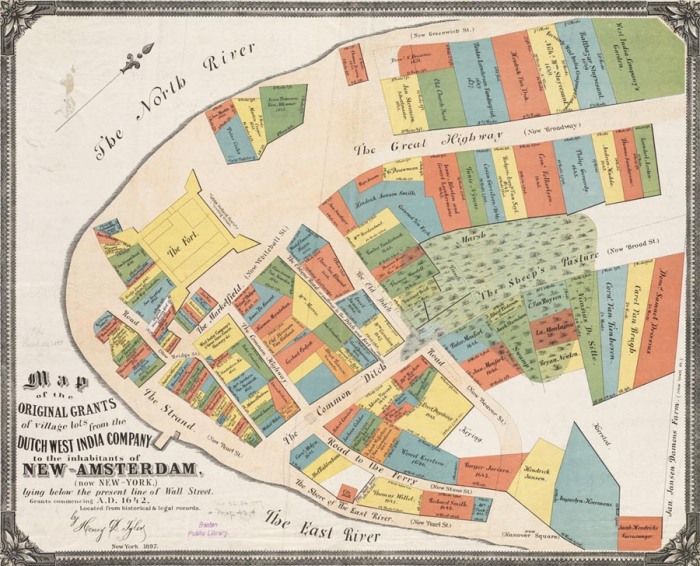
Prior to 1672, Gerrit Hendricksen (the butcher) purchased a building that “seems to have been used for business purposes” in New Amsterdam (Block H, Lots No. 2 of Castello Plan) from Jan Evertsen Bout. When his lot was confiscated, Gerrit Hendricksen (the butcher) stated he had been “ruined by the English” and “was unable to move“. Gerrit Hendricksen (the butcher) was then granted the house of William Paterson (Block Q, No. 22 of Castello Plan) for the “assessment of 2140 florins, and his land credited to him at 1660 florins” and he had “to pay the balance of 480 guilders“.[14]
- It should be noted that between 1500 and 1660, the home province of Sijtske Lieuwes (Friesland) had become a prominent destination for cattle shipped in from Western Germany and Denmark to be fattened and then butchered to be shipped to the southern provinces. Gerrit Hendricks de Wees may have learned the trade of slaughtering cattle from his wife’s family or while living in the area around the time of their marriage.
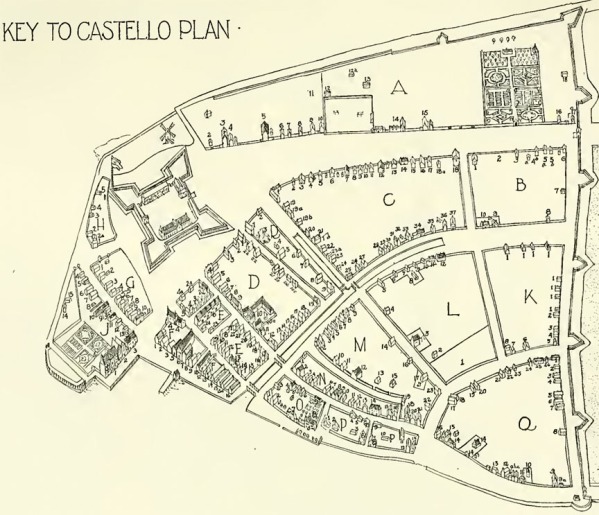
Gerrit Hendricksen properties (Block H, Lot 2 & Block Q, Lot 22) in New Amsterdam (Plate 82e – The Iconography of Manhattan Island 1498-1909, Volume 2).
On July 4, 1672, a list was recorded of colonist in New York who “have subscribed towards the reparations of James ffort” (originally known as Fort New Amsterdam). In the list of 136 colonist, “Gerrit hendricks Slaught’s” (a butcher) was recorded to have provided “½ mutton vall” worth 12 guilders (“Gerrit hendricks Slaught’s ½ mutton vall”).[15]
In July 1673, a Dutch fleet of 23 ships with 600 men from the Caribbean under the command of Admiral Cornelis Evertsen Jr. arrived of the coast of the American colonies to regain control of New York. Like Gerrit Hendricks de Wees, the majority of the population in and around New York City were of Dutch descent and quickly rallied to support of the Dutch. The British commander, Captain John Manning was forced to surrender Fort St. James (previously known as Fort New Amsterdam) when his 80 man company was surrounded by the Dutch with about 400 local “Dutch” militia (possibly including “Gerrit Hendricks de Wees“). After regaining control, the Dutch renamed the city “New Orange” and the fort was renamed “Fort Willem Hendrik” under the command of Captain Anthony Colve. A list of inhabitants taken by the Dutch in 1673 reported “Gerrit hendricksen” and “J___y Laurense” living next to each other between “Fresh Water and Harlem” on Manhattan Island.[16]
Captain Colve determined the dwellings (including that of “Gerritt Hendricks, butcher”) clustered on the southern and eastern sides of the newly named Fort Willem Hendrick were too close to the fortifications and needed to be removed. On October 8, 1673, the Governor advised the Burgomasters (chief magistrates) of the city “the necessity of demolishing or removing some houses and gardens situated under the walls of the fortress“. The owners were notified to appear before the court on October 10 and provided the following responses (see translation & second scanned page below):[17]
Translation: “…Pursuant to the resolution adopted yesterday, the persons whose houses and lots have been ordered removed are summoned to the meeting. The same being submitted by the Governor to each in particular, they answered as follows:”
- “Gerrit Janssen Roos, having already removed his house, is promised to be indemnified for his lot and moving on the valuation of arbitrators, with which he is satisfied.”
- “Willem van Vreedenburgh, having removed his house is, in like manner, promised satisfaction, with which he too is satisfied.”
- “Johannes van Brugh and Sara van Borsum are promised indemnity for their lots, with which they are content.”
- “Peter de Riemer is willing to remove his house, but requests Muyen’s lot or one at the Water side instead.”
- “Lodewyck Pos requests the house next the City Hall; otherwise ’twill be impossible for him to move.”
- “Jacobus van de Water requests Pattison’s house in Pearl-street, or a lot as near his former residence as possible, with satisfaction.”
- “George Cobbet says, he is unable to move unless assisted.”
- Jan Dircksen Meyer says, he knows not whither to turn, but finally requests a lot behind The Five Houses in Bridge-street.”
- “Andrew Meyer in like manner requests a lot there.”
- “Gerritt Hendricks, butcher, says, he has been ruined by the English and is unable to move; requests help and assistance.”
- “Peter Janssen Slott, by his father, requests a lot behind the City Hall.”
- “Simon Blanck requests accommodation for the winter, as his house cannot be moved; asks a lot behind The Five Houses.”
- “Peter Stoutenburgh, absent.”
- “Marten Jansen Meyer says, he is not able to move; is offered the lot next to Kip in the valley, or recommended to look up another.”
Lysbeth Tyssen is told that her small houses will be examined, to see whether they cannot be spared.” - “Peter Harmensen’s little house is in like manner to be examined.”
- “Peter Jansen Mesier requests a place on the Water side; otherwise cannot remove.
Ephraim Hermans requests satisfaction with others.” - “Doctor Taylor’s wife says, that her husband is willing to risk his house, and to abide the result.”
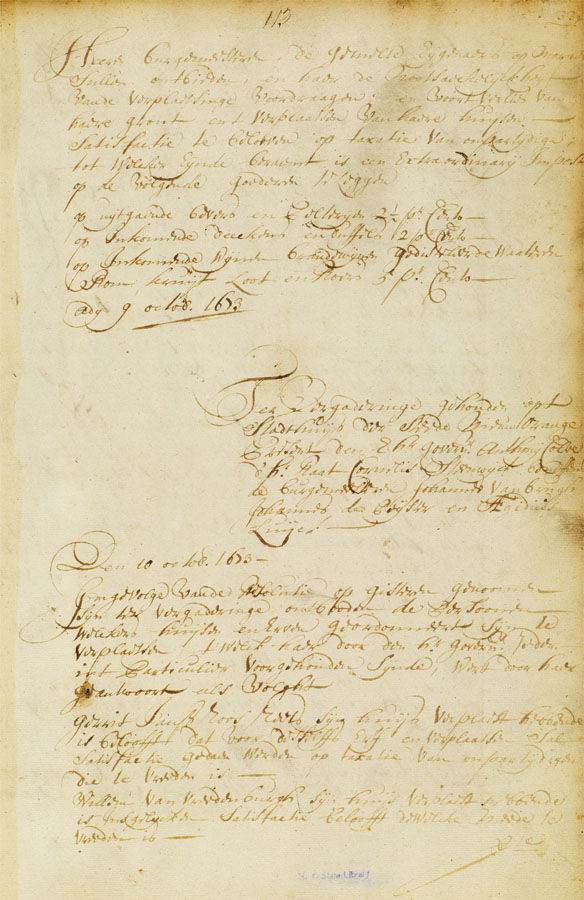
Scanned copy of the first page of the “Minute of arrangements for removal of houses near the fort” dated October 10, 1673 (New York State Archives. New Netherland. Council. Dutch Colonial Administrative Records, 1673-1674; Series A1881; Volume 23.1).

Scanned copy of the second page of the “Minute of arrangements for removal of houses near the fort” dated October 10, 1673 (New York State Archives. New Netherland. Council. Dutch Colonial Administrative Records, 1673-1674; Series A1881; Volume 23.1).
On October 16, 1673, the ordnance was passed for the removal of the houses and the owners (including “Gerrit Hendricx“) were to remove immediately (see translation below). The court then appointed “Cornelis Steenwyck, Johannis van Brugh, Johannis de Peyster, Egidius Luyck, and carpenters Abram Jansen and Jan Hendrickx Splinter” as commisioners to appraise the lots to defray the owners losses.
Translation: “Whereas Fort Willem Hendrick and the city of New Orange situate on Manhatans Island is seriously encumbered and weakened by the houses, gardens and orchards which lie so close under its walls and bulwarks that it is impossible to defend it properly when occasion requires against its enemies, unless at least some of those houses, lots and orchards be demolished and removed. It is therefore considered necessary by the Governor-General, by and with the previous advice of his Council, to demolish, pull down and remove the undernamed houses, gardens and orchards, and the owners thereof are hereby most strictly ordered and commanded instantly to commence demolishing and pulling down their houses, gardens and orchards, and to remove them to such lots as are laid out within this city by the Governor’s order to that end and shall be shown to each of them by the Burgomasters; on pain of depriving those who shall be found contumacious or negligent, of the indemnity which according to the terms of this Proclamation are granted and allowed to the following persons or those among them who shall come to remove their undernamed houses, gardens and orchards and, over and above, on the first arrival of any ships, of having their houses demolished or burned, to wit…”
“The houses, gardens and orchards of Situate under the walls and bulwarks of Fort Willem Hendrick: Peter de Riemer, Lodewyck Post, George Cobbet, Jan Dircksen Meyer, Jacobus van de Water, Symon Blanck, Andries Meyer, Gerrit Hendricx, Peter Jansen Slott…”
“The houses, gardens and orchards of Situate under the fortification and bulwarks of the city of New Orange…Gerrit Jansen Roos, Peter Stoutenburgh, Henry Taylor, The Lutheran Congregation, Willem van Vredenburgh, Peter Jansen Mesier, Martin Meyer Smith, Augustine Hermans, Lysbet Tyssen, Peter Harmsen…”
“The gardens and orchards of Situate under the fortification and bulwarks of the city of New Orange: Johannis van Brugh, Sara van Borsim.”
“But whereas said houses cannot be removed except at great and heavy expense to the proprietors, to whom, in return, indemnification and satisfaction ought, in equity, be allowed because said removal is done for the public benefit and better defence; it is therefore resolved that the grounds and lots belonging to said persons, with the necessary expense which they shall happen to incur in the removal of their houses, shall be valued by impartial persons, and to the proprietors instead of these lots shall be shown and conveyed, subject to like valuation, any other lots within this city to which they will be at liberty to remove, and whatever their cancelled lots and expenses of removing their houses will be found to exceed in value what shall be shown them instead, shall be promptly made good, fulfilled and paid to them from the extra duty which, for that purpose, it is resolved and ordered to collect from now henceforth until said indemnity and damage shall be prompt paid to said persons, and no longer, to wit…”
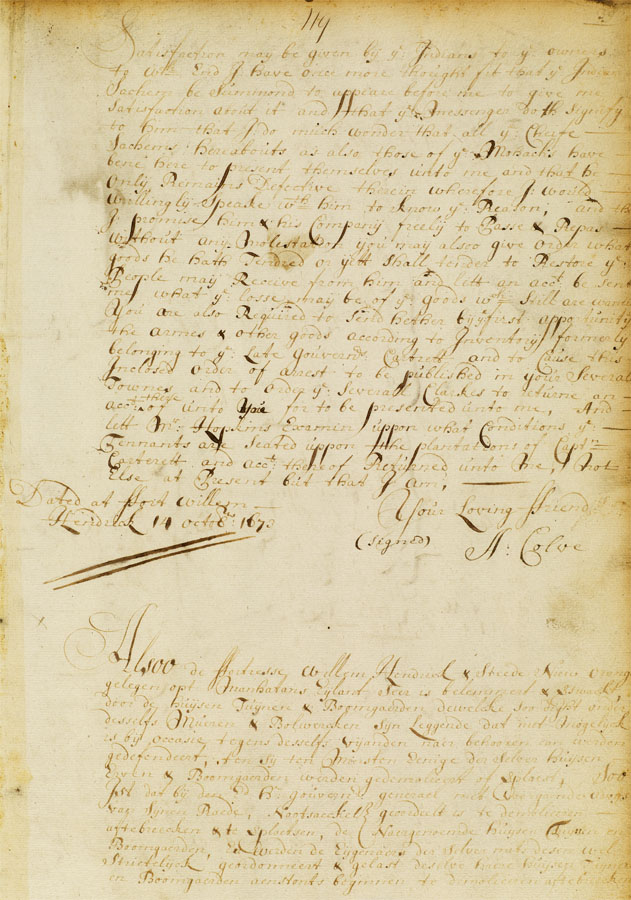
Scanned copy of first page of “Proclamation ordering the demolition of houses adjoining fort Willem Hendrick” dated October 16, 1673 (New York State Archives. New Netherland. Council. Dutch Colonial Administrative Records, 1673-1674; Series A1881; Volume 23.1).
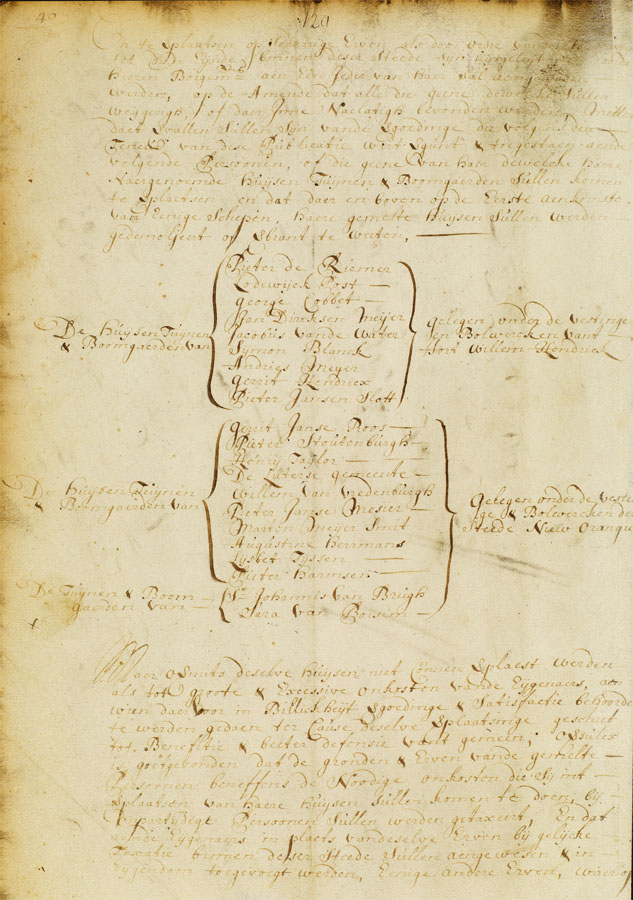
Scanned copy of second page of “Proclamation ordering the demolition of houses adjoining fort Willem Hendrick” dated October 16, 1673 (New York State Archives. New Netherland. Council. Dutch Colonial Administrative Records, 1673-1674; Series A1881; Volume 23.1).
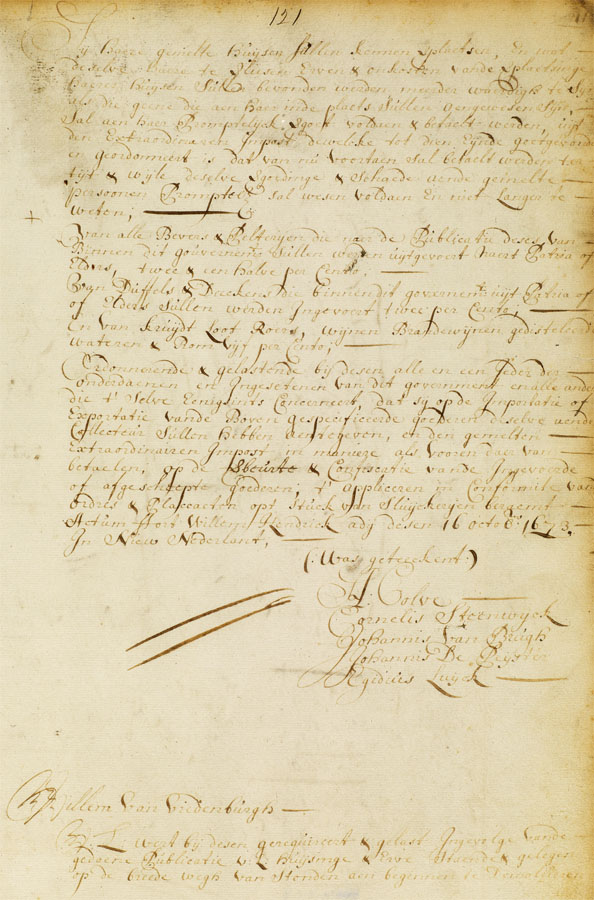
Scanned copy of third page of “Proclamation ordering the demolition of houses adjoining fort Willem Hendrick” dated October 16, 1673 (New York State Archives. New Netherland. Council. Dutch Colonial Administrative Records, 1673-1674; Series A1881; Volume 23.1).
On October 16, 1673, the officials published the “Valuation of the houses near the fort ordered to be demolished and of the lots given in stead“. The officials estimated for “Gerrit Hendrickse Butcher” the “house and lot in the Smith- street next…by his lot and removing his house” the cost was approved at “1,660 guilders“. The officials added there was a balance of “280 guilders” due “to Andries Rees which belonged to William Pattison” and the William Pattison house was assigned to “Gerrit Hendrickse Butcher” for “2,140 guilders” (see 3rd entry on page two below).
Translation: “List of the Valuation made by Messrs Cornelis Steenwyck, Johannis van Brugh, Johannis de Peyster, Egidius Luyck, and carpenters Abram Jansen and Jan Hendrickx Splinter, authorized by the Government commission to appraise and value the Houses and Lots which, according to the Proclamation, must be removed, as well as those given in their stead.” Listed on the first page were estimates for “Willem van Vredenburgh”, “Gerrit Jansen Roos”, “Peter Stoutenburgh”, “Ephraim Hermans” (“moved to 1/2 a lot in the Hoogh-straat behind William Pattenson’s house, occupied by Jan Buytenhuys”), and “Jacobus van de Water”. Listed on the second page were estimates for “George Cobbet”, “The Lutheran Congregation”, “Gerrit Hendrickse Butcher”, “Peter Jansen Mesier”, and “Martin Jansen Meyer Smith”. Listed on the second page were smaller reimbursements provided to “Johannis van Brugh”, “Sara van Borsim”, “Christiaan Lauwer”, “Jan Dirckse Meyer”, “Jan Dirckse Meyer”, “Andries Meyer”, “Symon Barentse”, “Peter Janse Slodt”, “Peter de Riemer”, “Lodewyck Post, on Pattison’s house…80 guilders”, and “Peter Harmse”.
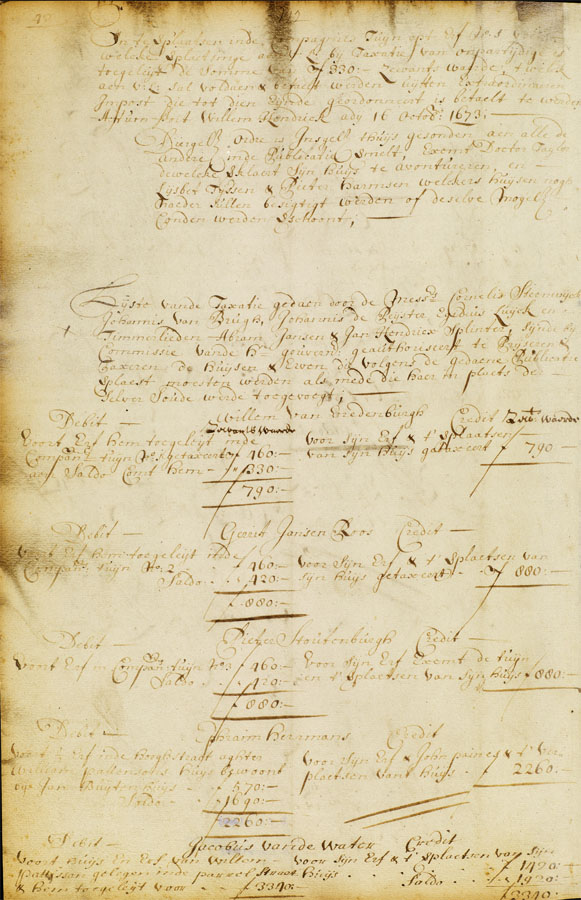
Scanned copy of first page of “Valuation of the houses near the fort ordered to be demolished and of the lots given in stead” dated October 16, 1673, (New York State Archives. New Netherland. Council. Dutch Colonial Administrative Records, 1673-1674; Series A1881; Volume 23.1)
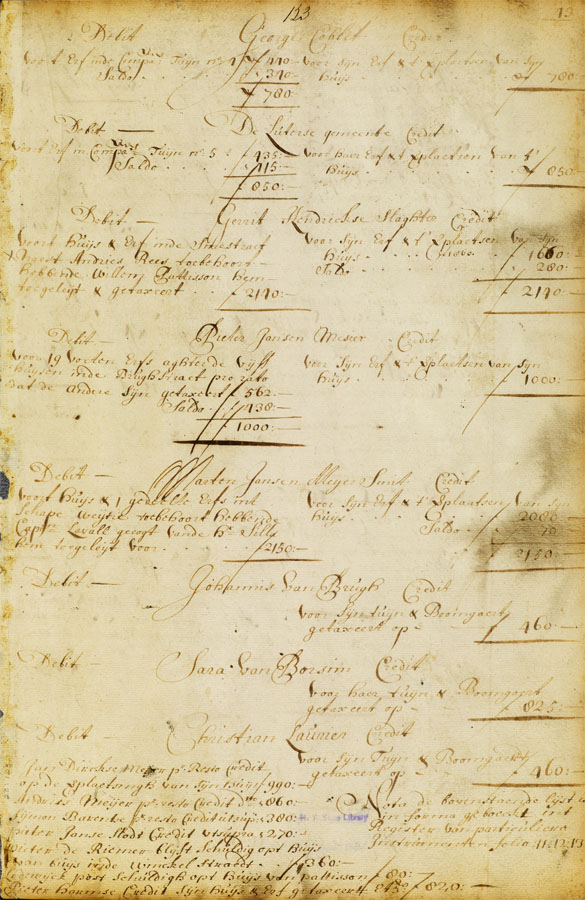
Scanned copy of second page of “Valuation of the houses near the fort ordered to be demolished and of the lots given in stead” dated October 16, 1673, (New York State Archives. New Netherland. Council. Dutch Colonial Administrative Records, 1673-1674; Series A1881; Volume 23.1)
On February 9, 1674, the Dutch returned New Orange (New York) to the British in the Treaty of Westminster and British reoccupied the port on November 10. According to a list of home owners prepared by the British in 1674, “Garret Hendricks…Dutch” was listed as living on Smith Street (now called William Street between Hanover Square and Wall Street) next to “John Ray…English“. The house of “Gerrit Hendricks” was “on the present south-west corner of Wall and William streets“. According to a list prepared when the Dutch surrender New Amsterdam to the British in 1664, “Cornelius Hendricksen, drummer, owned the premises on the south-west corner of Wall and William streets, containing twenty-six feet on Wall street and thirty feet on William street“.[18] Again, this suggests Gerrit Hendricks de Wees and his wife Sijtske Lieuwes were related to “Cornelis Hendrickszen” of “Putten bij den Briel” (Brielle of the Dutch Republic, located on the Island of Voorne-Putten) and his wife “Stÿntie Hermans” of Amsterdam who were married in the Dutch Reformed Church in “Nieuw Amsterdam” on May 14, 1655.[19]
On November 10, 1676, the tax assessments were made “for ye defrayinge of the Charges of the New docke & Payinge the Citty debts and other Publique dutyes att One Penny halfe Penny Pounde“. On the tax list, an entry was made for “Garrett Henderson butcher” for six shillings and three dollars. The only Hendricks/Hendrickson on the tax list were “ffrdrick Hendricks” and a “Dauid Hendrickson“; and the only other butcher listed was “Rowliff the butcher“.[20] This suggest “Garrett Henderson butcher” was likely a transcription error for our “Garrit Hendricks“.
- Note: According to the “Index of Conveyances Recorded in Office of Register of the City and County of New York” (page 265), “Garritt Hendricks” sold property in the City and County of New York to Jan J. Van Flensburgh on April 7, 1682 (Liber 12, Page 83). Interestingly, the date on the “Grantee” index listed the transaction date as “April 7, 1662” and the recorded date of “April 7, 1682” (could not locate Liber 12, Page 83). However, to date no additional information has been obtained.
On April 6, 1684, an Indenture was made by “Garrett Hendricks Dewees, of the Citty of New Yorke butcher on the one part and John Ray of the Citty of New Yorke Pipemaker of the other part“. For the consideration of five pounds, “Garrett Hendricx Dewees” conveyed “a small tract or parcell of land…John the Baker hath built upon lying in the High Street of New Yorke” to John Ray. The conveyance was free “of Dower of Sidy now wife of the said Gerrit Hendrix” (“Garrett Hendrix” is listed several times without the surname “DeWees“). The Indenture was signed by “Garrett Hendricks Dewees” and witnessed by Robert Darkins and Abraham Corbett.[21]
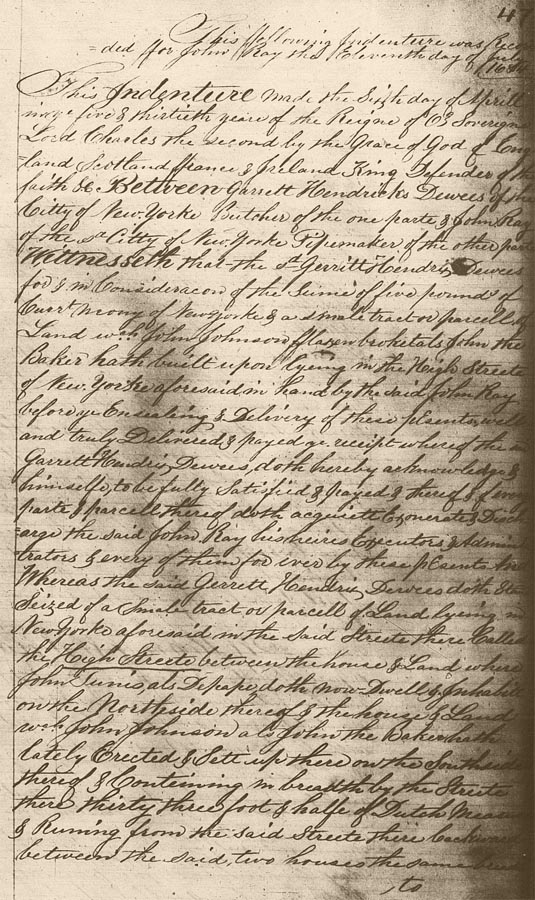
Conveyances of the City and County of New York, Liber 13, Page 47.
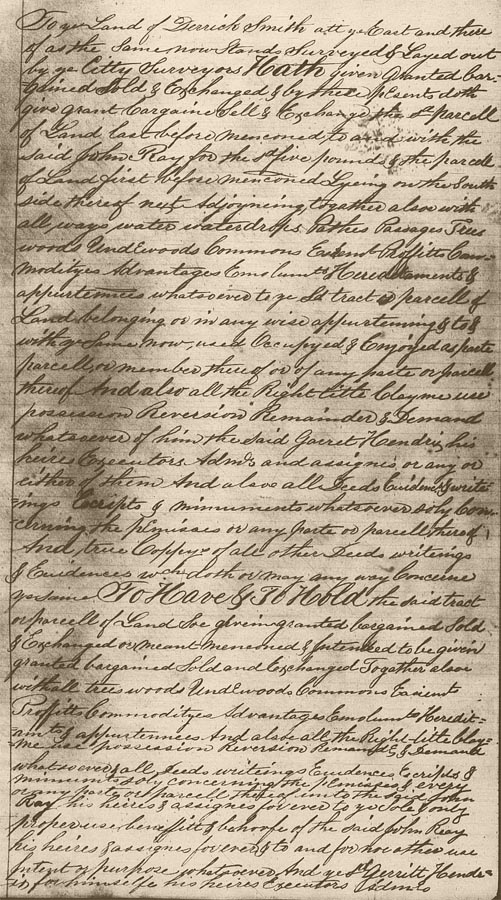
Conveyances of the City and County of New York, Liber 13, Page 48.
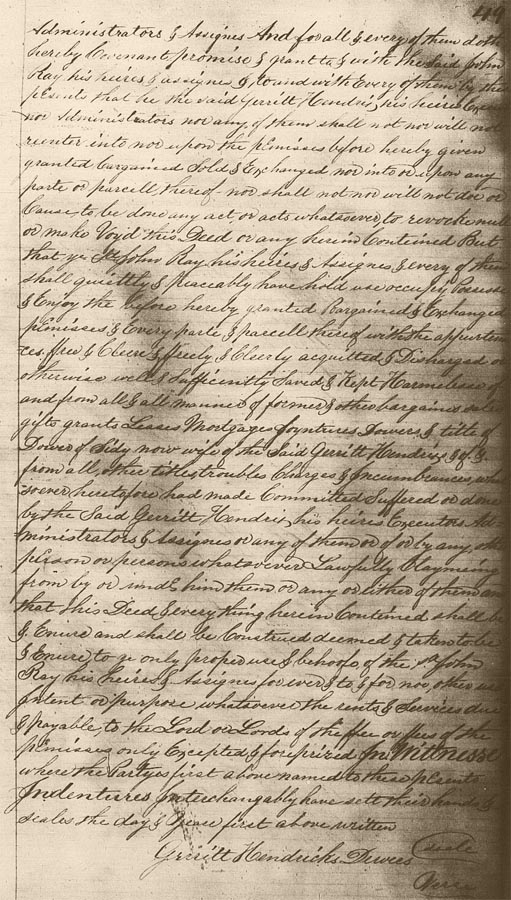
Conveyances of the City and County of New York, Liber 13, Page 49.
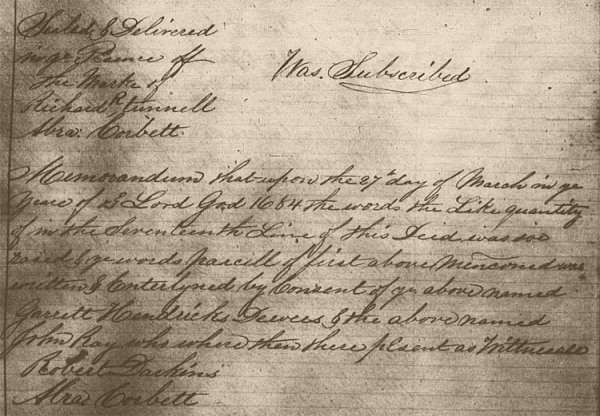
Conveyances of the City and County of New York, Liber 13, Page 50.
On April 26, 1689, the news reached New York that the militia in Boston had “revolted” and arrested the Royal British Governor on New England in Boston amid the fears of the colonial Protestants that Catholics in Britain (including the King) were plotting to stamp out the Protestant faith. On the same day (May 10, 1689) militias on Long Island proclaimed support for the actions in Boston, “Claes Rittenhúÿsen, bachelor, from Aernhem, and Willemÿntie de Wees, spinster from Lieùwarden” were registered with the Dutch Reformed “Collegiate” Church on Manhattan (New York City) to be married. The oldest daughter of Gerrit Hendricks de Wees and his wife Sijtske Lieuwes, Willemyntie Pietre de Wees, was married to Nicholas (Claus) Rittenhouse by Dominie (minister) “Henricus Selÿnsi” of the Dutch Reformed Church on May 29, 1689. At the time they were married, Claes Rittenhúÿsen was living in South River (see below) and Willemyntie de Wees was living in New York.[22] Nicholas (Claus) Rittenhouse was the son William Rittenhouse (Willem Rittinghuysen), “the founder of paper making” in the colonies and reportedly the first Mennonite minister in Pennsylvania.
- The Delaware Valley and its bay were known to the Dutch as “South River”. The Dutch had established Fort Nassau on the Delaware River (known to them as “South River”) and Big Timber Creek (across the river from where Philadelphia would be established) to gain control of the region in 1655 from the New Sweden Colony based in Fort Christina (present-day Wilmington, Delaware).
- Mennonites were followers of Menno Simons (1496-1561), a Dutch Catholic priest from the Province of Friesland (the Frisian version of his name is Minne Simens) in the Dutch Republic that left the Catholic Church in 1536 and joined “The Swiss Brethren” (originated in 1525 in Zurich, Switzerland) as part of the Anabaptism movement (did not believe in infant baptisms) and became a prominent pacifist leader in the Protestant Reformation.
On August 20, 1689, the 47 year old “Garrit Hendricks” from Amsterdam was was one of the soldiers listed as serving in Captain Jacob Leisler’s Company of New York militia.[23] This indicates Gerrit Hendricks (de Wees) supported Captain Leisler taking command after the militia seized control of Fort James on May 31, 1689. With the support of his select company of paid militia, Captain Leisler would assume the position of Lieutenant-Governor of the Province of New York after the militia had forced the British appointed Lieutenant-Governor to flee to London (see Gerrit Hendricks (de Wees) and Leisler’s Rebellion).
After almost 27 years of building a new life in New York, Garrett Hendricks de Wees decided to start over and moved his family approximately 100 miles southwest to German Township (near Philadelphia, Pennsylvania) by March of the following year. On March 1, 1690, Gerrit Hendricks deWees purchased 50 acres in German Township in the old Province of Philadelphia (Pennsylvania) from Dirck Sipman (through Sipman’s attorney Herman de Graff). About 30 acres of the land was a town lot bounded on the southeast by lands owned by William Rittinghousen (the father of his son-in-law) and on the northwest by Derk Keyser. The other 20 acres was an outside lot also bounded by William Rittinghousen and Derk Keyser. The contracted price was set at “Two Rix dollars or two pieces of eight” yearly forever (see below transcription below).[24]
“By these Presents be it known to all whom it may concern. THAT WHEREAS. Dirck Sipman at present residing in the city of Crefelt in the county of Cologne, did purchase of William Penn. Proprietor and Governor of the Province of Pennsylvania. Certain 5,000 acres of land in the said Province whereof he is at present in lawful possession and of which I Herman op de Graff by virtue of the full powers unto me for that purpose given. Do grant unto Gerrett Hendricks deWees under the yearly rent of two Rix Dollars or 2 pieces of Eight yearly forever. Certain 50 acres of land situate in the German Township part whereof consists in a Town lot of the breadth of 14 Perches and 4 feet. Bounded on the one side towards the South East by William Reittinghousen, and on the other side towards the North West by Dirck Keysers Land extending Westward to the Main Street and Northward to the German Township line and containing XXX acres and the remaining XX are situate amongst the said Germantown outside lotts extending and bounded also on the southeast by William Reittinghousen on the northwest by Dirck Keyser, Northward by the Township line, and Westward by the division street, and of the same breadth of XXX Perches Which 50 acres of Land situated as above I the said Herman op de Graff as attorney of (and in the name of) the said Dirck Sipman do hereby grant unto the said Gerrett Hendricks de Wees, Together with all the rights, titles and interests of the said Dirck Sipman of, in and to the same to the intent and purpose that the said Gerrett Hendricks de Wees his Heirs and Assigns hereafter forever possessing the same shall and may peaceably and unmolested, have hold and possess the same herein granted Land with any claim and demand of the aforesaid Dirck Sipman his Heirs and Assigns. On the other hand the said Gerrett Hendricks de Wees hereby binds himself his Heirs and Assigns yearly on the first day of the first month commonly called March to pay unto the said Dirck Sipman his Heirs and As signs forever, The said yearly rent of 2 Rix Dollars or 2 pieces of Eight the payment of which yearly rent to be made in the year 1691 on the first day of March.”
“And lastly the said Gerrett Hendricks de Wees shall be obliged in order for the more better assurance of his right to the said (50) acres of Land to cause this present grant or a sufficient Extract thereof to be duly entered into the appointed Public Town Record.”
“In Testimony whereof the Parties have set their hands and Seals hereunto. Done at Germantown 1690 the 1st day of the first month commonly called March.”
Witnesses: “Herman op de Graff (Seal) Isaac Shumaker. Gerret Hendricks de Wees (Seal) Paul Wulff. Passed in the Court of Records ye 22nd. 9th. M. 1698.”
On “the 14th day of the 4th month” (June) in 1692, “Gerrit Hendriks and Sytje his wife delivered unto Aret Klincken an indenture of apprenticeship concerning their son William Gerrits“.[25] Aret Klincken (Arendt Tunis) reportedly built the first two-story house in Germantown and declined to be a burgess (member of Parliament) due to his religious convictions. Aret Klincken would be one of the three “overseers” who collected the subscriptions and assisted Francis Daniel Pastorius open the first school in Germantown by Francis Daniel Pastorius in 1702. Wilhelm “William” de Wees (son of Gerrit Hendriks & Sytje) and his brother Cornelius de Wees, both sent their children to Pastorius’ school.
On “the 18th of the 8th month” (October) in 1692, “Gerrit Henrix delivered unto Andrew Souply an indenture of apprenticeship concerning his son Lamber[t] Gerrits“. A weaver by trade, Andris Souplis (Supplee) was a Huguenot that had fled the persecution in France to New York in 1685 and then removed to Germantown around the same time as Gerrit Hendricks de Wees. On “the 13th of the 9th month” (November) in 1694, “Lambert, the son of Gerret Hendricks” submitted to the court for behaving “abusively against Peter Schumacker, Jr“. On “the 25th day” of the next month the court fined “Lambert, the son of Gerret Hendricks” 10 shillings for his abusive behavior.[26]
On May 15, 1693, the General Assembly passed the first law assessing taxes on property of the inhabitants of Philadelphia County, Pennsylvania. A transcription of the fifty-two inhabitants subject to tax assessments living in “German Town” that year (1693) listed “Gerrit Henrix” as living between “Dirick Keyser” and “William Ruttinghuyson” (the father of his son-in-law, Nicholas Claus Rittenhouse). Living next to “William Ruttinghuyson” was “Andrew Souplis” and living a couple of households away was “Aert Klinken” and “Paul Castern” (Kuster). Also listed were the son-in law of Gerrit Hendricks de Wees, “Claws Rutting Heysen“, “Mary Henrix” (the widow of yet another Gerrit Hendrix), along with “Rineir Hermans“, “Daniel Pastorius” and “William Streipers“.[27]
- Mary Hendrix had arrived in Philadelphia onboard the ship “Francis and Dorothy” after a voyage from London along with her husband Garret Hendrix (Gerhard Hendrich) daughter Sarah, and her servant Henry Fry. Also arriving on the same ship was Peter Shoomaker (Schumacker) and his son Peter (Peter Schumacker, Jr). It is this Gerrit Hendrix (a German Quaker) that signed the 1688 Germantown Quaker Petition Against Slavery (Gerrit Hendricks de Wees was still in New York at this time).[28]
The Quakers (Society of Friends) acquired a new burial place in Philadelphia around 1693-1694 (the title was conveyed in 1701) on Arch street and 4th Street (Arch Street Meeting House Burial Ground). In 1794, the a committee reported the grounds were so full, another needed to be procured. A list of burials of non-Quakers “within the town of Philadelphia” prepared by Wm Hudson included “Hendrycus Dewees d. 6-30-1694“.[29] It is likely this was the 16 year-old son of Gerrit Hendricks de Wees and his wife Sytie Lieuwes (“Hendrick”) that was been baptized in the city of New York on October 13, 1677.
Sometime in 1701, Gerrit Hendricks de Wees appears to died as his widow Zytian de Wees sold the 50 acres purchased from Dirck Sipman on March 1, 1690. Likely to settle the estate of her husband, “Zytian de Wees widow of Gerric Hendricks deWees” was represented by her son-in-law Claus Ruttinghuysen (Reittinghousen) in the sale of 25 acres to John Conrad Cod Weis of Germantown for “23 pounds current silver money” on December 23, 1701. Similarly, Claus Ruttinghuysen represented Zytian de Wees in the sale of the other 25 acres to John Henry Mehls “for the sum of 17 pounds” (witnessed by neighbors Arret Klinkin & Peter Keyser).[30]
“THIS ENDENTURE made the 23d. day of December one thousand seven hundred and one between Claus Ruttinghuysen, lawful Attorney of Zytian de Wees widow of Gerrit Hendricks deWees. on the one part, and John Conrad Cod Weis of Germantown on the other part, for and in consideration of 23 pounds current silver money of Pennsylvania a certain half lot containing 25 acres. and a further consideration of a yearly rent of six shillings to be paid to Dirck Sipman his Heirs and Assigns forever. Witnessed by Hans Senrussmirls. Peter Keyser.“[31]
John Conrad Codweis would sale the 25 acres he had purchased from “Zytian de Wees widow of Gerrit Hendricks deWees” back to the son of Gerrit Hendricks de Wees (William DeWees) on October 2, 1703. Curiously, the indenture stated John Conrad Codweis had purchased the 25 acres form Zytian de Wees several months earlier (April 28, 1701) instead of December 23, 1701.[32]
“This Indenture made October 2nd. 1703. between John Conrad Codweis of Germantown county of Philadelphia, Province of Pennsylvania, on the one part. and William Dewees of the same Township, County and Province on the other part. WITNESSETH THAT THE SAID John Conrad Codweis for and in consideration of the sum of twenty seven pounds, current silver money of Pennsylvania which sum is secured to be paid by a bill of mortgage under the said William Dewees’s hand and seal bearing date with these presents, the receipt whereof lie the said John Conrad Codweis doth hereby acknowledge, and for both acquit and discharge the said William Dewees his heirs and assigns forever. doth Grant, Bargain &c a certain half lot in Germantown March unto Gerard Hendricks de Wees by a deed of Enfoeffin dated the first of March 1690. acknowledged in open court March Conrad Codweis, by virtue of a deed of sale from the above mentioned Gerard Hendricks de Wees’ widow Zytian dated the 18th day of April 1701. acknowledged in a court of records, held at Germantown 1703. John Conrad Weis“.[33]
- Sometime around 1704, the son of Gerrit Hendricks de Wees (Wilhelm de Wees) married the daughter of John Henry Mehls (Anna Christina Mehls). A prominent member of the Dutch Reformed Church, John Henry Mehls (Hans Hendrick Meels) was named the “Recorder” of Germantown on June of 1701.[34]
- In 1706, the son of Gerrit Hendricks de Wees (Lieuwes “Lewis” Lambert de Wees) married Mary Wheeler in Sussex County (Delaware) where he “was a weaver by trade” in Kent County, Delaware (located about 75 miles south of Germantown, Pennsylvania).[35]
- A short time prior to February 23, 1708, the son of Gerrit Hendricks de Wees (Cornelius de Wees) married the daughter of Paulus Kuster (Margaret Kuster) in or nearby Germantown, Pennsylvania.[36] Like the original thirteen Quaker/Mennonite families that founded German Town in 1683, Paulus Kuster (Castor) and his wife Gertrude emigrated from the Rhineland region near Krefeld (Germany) that had been under Dutch rule since 1598.
Gravestones:
Gerrit Hendricks de Wees and his wife Sijtske Lieuwes are both reportedly buried in the Upper Burial Grounds of Germantown (aka: Axe’s Burial Ground & Concord Burying Ground) located at Germantown Avenue and Washington Lane in Philadelphia County, Pennsylvania. Their son Wilhelm “William” de Wees and his wife Christina Dewees are also buried in the Upper Burial Grounds of Germantown.
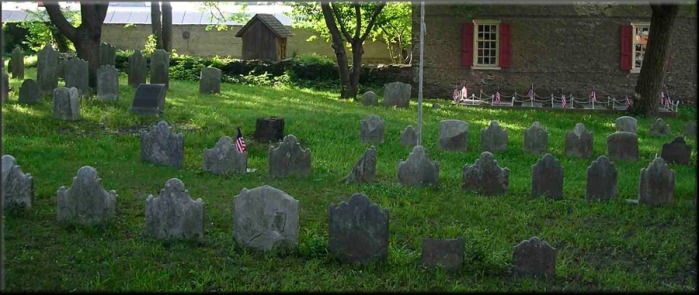
Picture from findagrave.com of the Upper Burial Grounds of Germantown.
[1] Established by Colonel George Byers of South Bend, Indiana, the Dewees National Research Team is an informal group of Dewees descendants who are working jointly to compile the history of this family in America.
[2] “Gerrit Hendricks de Wees: 17th Century Dutch Immigrant to New Amsterdam” by Curtis DeWees and Jack C. Vaughn; The New York Genealogical and Biographical Record, January 1994, Volume 125, No. 1, Pages 1-7.
[3] “A Study on the Family Placement of Lewis DeWeese Eldest Son of Dutch Immigrant Gerrit Hendricks De Wees of New Amsterdam and Germantown” by Jack C. Vaughn and Ted D. DeWeese (Amsterdam Orphans’ Administrations 31:59, 24 November 1661).
[4] Leeuwarden Reformed Dutch Church Marriage Records (Family History Library film #108,004, Volume 6, Page 68); “Gerrit Hendricks de Wees: 17th Century Dutch Immigrant to New Amsterdam” by Curtis DeWees and Jack C. Vaughn; The New York Genealogical and Biographical Record, January 1994, Volume 125, No. 1, Page 6.
[5] “Gerrit Hendricks de Wees: 17th Century Dutch Immigrant to New Amsterdam” by Curtis DeWees and Jack C. Vaughn; The New York Genealogical and Biographical Record, January 1994, Volume 125, No. 1, Page 6.
[6] The DeWees Family: Genealogical Data, Biographical Facts and Historical Information collected by Mrs. Philip E. LaMunyan, Page 14.
[7] “Soldiers of the Company: the Military Personnel of the West India Company in Nieu Nederlandt” by Jaap Jacobs (Jacob Leisler’s Atlantic World in the Later Seventeenth Century), Pages 17-19.
[8] Documents relative to the colonial history of the state of New-York : procured in Holland, England, and France by John Romeyn Brodhead Esq, Pages 75-77; “Gerrit Hendricks de Wees: 17th Century Dutch Immigrant to New Amsterdam” by Curtis DeWees and Jack C. Vaughn.
[9] The records of New Amsterdam from 1653 to 1674 Anno Domini (Volume V, Minutes of the Court of Burgomasters and Schepens January 8, 1664 to May 1, 1666) edited by Berthold Fernow, Page 347; “Gerrit Hendricks de Wees: 17th Century Dutch Immigrant to New Amsterdam” by Curtis DeWees and Jack C. Vaughn.
[10] The Iconography of Manhattan Island (1498-1909), Volume 2, by Isaac Newton Phelps Stokes, Page 248; “Gerrit Hendricks de Wees: 17th Century Dutch Immigrant to New Amsterdam” by Curtis DeWees and Jack C. Vaughn (New York Genealogical and Biographical Record. 1870, 9:140).
[11] “Gerrit Hendricks de Wees: 17th Century Dutch Immigrant to New Amsterdam” by Curtis DeWees and Jack C. Vaughn (New York Genealogical and Biographical Record. 1870, 9:140).
[12] Records of the Reformed Dutch Church in New Amsterdam and New York: Baptisms from 25 December 1639 to 27 December 1730 edited by Thomas Grier Evans, Pages 75-156.
[13] The records of New Amsterdam from 1653 to 1674 Anno Domini (Volume VI, Minutes of the Court of Burgomasters and Schepens May 8, 1666 to September 5, 1673) edited by Berthold Fernow, Page 218.
[14] The Iconography of Manhattan Island (1498-1909), Volume 2, by Isaac Newton Phelps Stokes, Page 276.
[15] Documents of the Assembly of the State of New York, 1897, Volume XIII, No. 68, Pages 330-336 (Page 333).
[16] Annual Report of the State Historian, Volume 3, Page 441.
[17] Manual of the Corporation of the City of New York, Pages 632-633.
[18] “List of the Owners of Houses and Lots in the City, About 1674, at the Final Cession to the English…“, History of the City of New York by David T. Valentine, Pages 130, 184 & 327.
[19] “Marriages from December 11, 1639 to August 26, 1801” Records of the Reformed Dutch Church in New Amsterdam and New York edited by Samuel S. Purple, Page 19.
[20] The New York Genealogical and Biographical Record Volume II, No. 1, (January 1871) Pages 36-38.
[21] Conveyances of the City and County of New York, Liber 13, Pages 47-50; “Gerrit Hendricks de Wees: 17th Century Dutch Immigrant to New Amsterdam” by Curtis DeWees and Jack C. Vaughn.
[22] Dutch Reformed Marriage Records of New Amsterdam & New York City by Robert L. Billard, Page 67; The DeWees Family: Genealogical Data, Biographical Facts and Historical Information collected by Mrs. Philip E. LaMunyan, Page 14.
[23] “Statement Etc, of Ensign Joset Stoll, August 20, 1689“, Collections of the New-York Historical Society for the Year 1868, Page 297. The Director of the Jacob Leisler Institute, Dr. David William Voorhees, confirmed “Gerrit Hendricks, age 47, from Amsterdam appears in the August 20, 1689, list of Jacob Leisler’s Militia Company sent as an enclosure in a letter to King William and Queen Mary“; “Gerrit Hendricks de Wees: 17th Century Dutch Immigrant to New Amsterdam” by Curtis DeWees and Jack C. Vaughn (New York Genealogical and Biographical Record 94:67)
[24] Deed Book I, Volume 9 (Philadelphia County, Pennsylvania), Page 218; The Michael Shoemaker (Schumacher) Book by Williams T. Blair, Page 751; The DeWees Family: Genealogical Data, Biographical Facts and Historical Information collected by Mrs. Philip E. LaMunyan, Pages 15-16.
[25] “Extracts from Records of Court held in Germantown, from 1691 to 1707” (Collections of the Historical Society of Pennsylvania, Volume 1), Page 243; “Gerrit Hendricks de Wees: 17th Century Dutch Immigrant to New Amsterdam” by Curtis DeWees and Jack C. Vaughn (Germantown, Pennsylvania, Court Records Book, 1691-1707, page 3; original examined at The Historical Society of Pennsylvania).
[26] “Extracts from Records of Court held in Germantown, from 1691 to 1707” (Collections of the Historical Society of Pennsylvania, Volume 1), Pages 244-245; “Gerrit Hendricks de Wees: 17th Century Dutch Immigrant to New Amsterdam” by Curtis DeWees and Jack C. Vaughn (Germantown, Pennsylvania, Court Records Book, 1691-1707, page 5).
[27] “The First Tax List for Philadelphia County” (The Pennsylvania Magazine of History and Biography, Volume 8), Pages 98-99; William Penn and the Dutch Migration to Pennsylvania by William I. Hill, Pages 417-418.
[28] The Friend, A Religious and Literary Journal (Volume 48, No. 9, dated October 17, 1874), Page 67; “Gerrit Hendricks de Wees: 17th Century Dutch Immigrant to New Amsterdam” by Curtis DeWees and Jack C. Vaughn (Passengers and Ships Prior to 1684, Publications of the Welcome Society of Pennsylvania, No. 1, 1970, Page 166).
[29] Encyclopedia of American Quaker Genealogy (Volume 2) by William Wade Hinshaw, Page 443; The Friend, A Religious and Literary Journal (Volume 63, No. 25, dated January 18, 1890), Page 194.
[30] The DeWees Family: Genealogical Data, Biographical Facts and Historical Information collected by Mrs. Philip E. LaMunyan, Pages 16-17 (Exemplification Records, 8, 392, L.).
[31] The DeWees Family: Genealogical Data, Biographical Facts and Historical Information collected by Mrs. Philip E. LaMunyan, Pages 16-17 (Exemplification Records. I, 390).
[32] The DeWees Family: Genealogical Data, Biographical Facts and Historical Information collected by Mrs. Philip E. LaMunyan, Pages 16-17.
[33] The DeWees Family: Genealogical Data, Biographical Facts and Historical Information collected by Mrs. Philip E. LaMunyan, Pages 16-17 (Exemplification records, No. 8, Page 386, Recorder of Deeds’ Office, Philadelphia, Pennsylvania).
[34] The Perkiomen Region, Past and Present, Volume 2, edited by Henry Sassaman Dotterer, Page 40; The DeWees Family: Genealogical Data, Biographical Facts and Historical Information collected by Mrs. Philip E. LaMunyan, Page 37.
[35] The DeWees Family: Genealogical Data, Biographical Facts and Historical Information collected by Mrs. Philip E. LaMunyan, Pages 19 & 211; “A Study on the Family Placement of Lewis DeWeese Eldest Son of Dutch Immigrant Gerrit Hendricks De Wees of New Amsterdam and Germantown” by Jack C. Vaughn and Ted D. DeWeese.
[36] The DeWees Family: Genealogical Data, Biographical Facts and Historical Information collected by Mrs. Philip E. LaMunyan, Pages 133 & 162; Book C. (C.72) – Abstracts of Philadelphia County Wills (1682-1747), Page 98 (Need to confirm Citation).
I am William Manthorpe. Through my Father’s mother Hannah Mary Hoffman, I am related back to Garrett Hendricks Dewees.
I am a naval historian and the author of three books on the naval history of Delaware. At the urging of my family I have just turned my efforts to writing on the Dewees family members who served in the American Revolution. I intend to do so in parts or chapters (depending on length) for each branch from Wilhelmina, William, Cornelius and Lewis. Each has descendants in the War. Prior to those parts or chapters, however, some background on Garrett Hendricks had to be included. Naturally, I began my work with the work of Mrs. Philip E. La Munyan, The Dewees Family. But, in expanding my research I came across this great blog. These pages have already changed what I though I knew about Garrett Hendricks and each of his children about whom I will write. I am sure the family pages on other Dewees will be just as valuable. Thanks to the “Dewees National Research Team” and the Wilson Family Blog for discovering all this information and making it available, I will certainly add my contributions as done and when done.
William Manthorpe
LikeLike
Appreciate your kind words and look forward to updating our pages with citations to information from your book. The more we share, the more we learn about and understand the stories of these remarkable ancestors. Gob Bless!
LikeLike
I am Erik Peterson and am a direct descendant of Garrett Hendricks De Wees through my mothers line. Her father and my Grandfather Max Irwin DeWeese; Great Grandfather Max Charles DeWeese; 2nd Great GF Josiah F. DeWeese; 3rd Great GF Cornelius DeWeese Jr.; 4th Great GF Cornelius H. DeWeese Sr.; 5th Great GF Jonathan DeWeese; 6th Great GF Lieuwes L. De Wees; and 7th is Garrett Hendricks De Wees. I just recently started researching my ancestry and would love any further information about my kin or any resources where I could do more in-depth research such as the gentleman’s book mentioned in a previous comment. Thank you for this work, it is invaluable!
LikeLike
Glad you find the information helpful. If you are prescribed to our blog, you will receive a notification regarding William Manthorpe’s book as soon as it is made available to us. God Bless!
LikeLike
I am descended from Claus Rittenhouse and Willamynte DeWeese. Thank you for adding so much to La Munyan’s work.
There was an Abraham DeWeese who moved from Montgomery Co Pa. to Va. and returned to Pa during the rev war with Bland’s Dragoons.
FYI the Henry Antes House in Frederick Twp Montgomery County Pennsylvania has been restored and is open to the public – https://goschenhoppen.org/
I am a member of the Philadelphia Continental Chapter SAR and the 13 star Flags in the background of the photo of Upper Burial Ground in Germantown are place by me and another member around Memorial Day each year.
LikeLiked by 1 person
Glad you like the blog & thanks for the update on the Henry Antes house. Someday, I would love to travel across the country & visit Rittenhouse Town. Hope you enjoyed the other posts, including the family page for Claus Rittenhouse & his wife Willemyntie. This blog is the result of descendants and researchers sharing what they have learned so that we can continue to build on what we know by sharing the stories of these remarkable ancestors. One of these descendants, William Manthorpe has been working on a book he is posting with us that will focus on the service this branch of the family in the Revolutionary War so this may include insight into Abraham DeWeese & Bland’s Dragoons. Hope you will consider subscribing to our blog so that receive notification of new posts and you can continue to share updates from Germantown. God Bless!
LikeLike
This is an amazing collection of information on the life and family of Gerrit Hendricks de Wees and Sijjske Lieuwes, my 9th great grandparents, who I believe to be my earliest ancestors in America. I descend from them through my paternal side, through their daughter Willemyntie, wife of Claus Rittenhouse, and from Willemyntie & Claus’s daughter Susanna, wife of Hendrick Heilig. I am literally stunned by the amount of information here and the quality of the presentation, especially how the data is all tied together and put in its historical perspective, complete with images of documents, maps, etc.It’s more than I ever hoped to find. Thank you so much for pulling this all together and presenting it so well! BTW – I hope you can make it to Rittenhouse Town some day. I live in the Philadelphia suburbs and have visited with my family. It is a special place, especially when one has family ties to it.
LikeLike
Glad you found us! Appreciate your kind words, this site was made possible by so many descendants and researchers that have shared family stories and the documentation they have found over the years. Someday, I would love to visit Rittenhouse Town. We are certainly fortunate that this portion of our shared family history has been saved. God Bless!
LikeLike